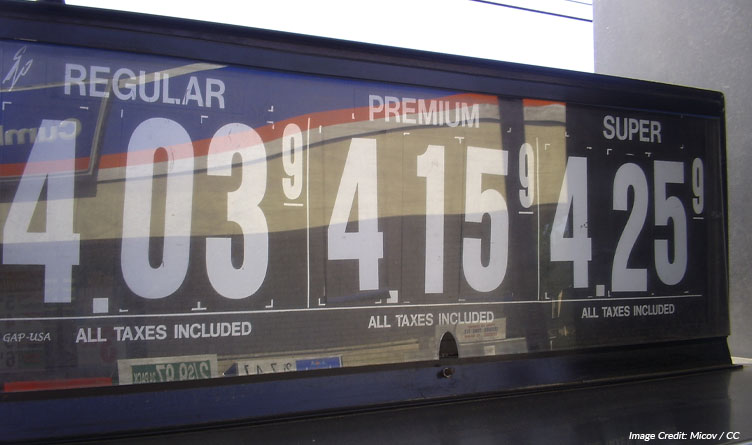Analysts predict crude to hit $200 a barrel
By Bethany Blankley [The Center Square contributor] –
The average price for regular gasoline topped $4 a gallon Monday, the first time motorists paid so much at the pump since 2008.
Analysts predict gas prices will continue their climb, and crude oil could hit $200 a barrel.
The national average for regular gasoline was $4.065 a gallon Monday compared to the $3.610 average a week ago, $3.44 average a month ago and $2.768 average a year ago, AAA reports. California continues to have the highest average price of $5.34 a gallon.
The 10 states that saw the largest weekly increases are Rhode Island (+58 cents), Nevada (+57 cents), Connecticut (+56 cents), Kentucky (+56 cents), Alabama (+56 cents), West Virginia (+55 cents), Virginia (+55 cents), Massachusetts (+54 cents), New Hampshire (+52 cents) and New Jersey (+52 cents), AAA reports.
The 10 most expensive markets in the U.S. are California ($5.34), Hawaii ($4.69), Nevada ($4.59), Oregon ($4.51), Washington ($4.44), Alaska ($4.39), Illinois ($4.30), Connecticut ($4.28), New York ($4.26) and Pennsylvania ($4.23).
“The all-time high for the national average retail price of gasoline was $4.114 set July 17, 2008,” Andrew Lipow of Houston-based Lipow Oil Associates LLC, told The Center Square in an email. “And we will break that record Tuesday as the national average heads to $4.50.”
The all-time high for the national average retail price of diesel was $4.845 on July 17, 2008.
“We will break that record in the next few days as the national average heads to $4.90,” Lipow added.
Gas prices at the pump, and all costs impacted by gasoline prices, will continue to rise as the Biden administration continues to restrict U.S. domestic oil production, analysts say, and expands reliance on foreign production, which is greatly impacted by the Russia-Ukraine conflict. The U.S. and others are considering a ban on importing Russian crude as its invasion of Ukraine continues.
The WTI Crude hit $130 a barrel Sunday night, dropping to $121 a barrel Monday morning, with Brent Crude surpassing $123 a barrel.
By comparison, on Wednesday, Feb. 23, the day before the Russian invasion of Ukraine, the WTI was $92 a barrel.
“The market is pricing in a 3 million barrel per day disruption,” Lipow said. “A complete ban on Russian exports will lead to $150+ per barrel. This is happening at the same time 330,000 barrels per day has been shut in Libya by protesters and 400,000 barrels per day is offline in Iraq due to field maintenance.”
***Click HERE to support Conservative Journalism in Tennessee. We can’t bring you articles like this without your support!***
Analysts at Bank of America predict that if the majority of Russian oil exports are cut off, there could be a 5 million barrel per day shortfall, causing crude to hit $200 a barrel, Reuters reported.
If Russian oil supply faces continued disruption, Brent could end the year at $185 per barrel, JPMorgan analysts forecasted, according to Bloomberg News.
On Feb. 23, the national average retail price for diesel was $3.96. Today it’s $4.61, with California having the highest average of $5.69.
On Feb. 23, gasoline futures prices were $2.72 a gallon, Lipow notes, now up 96 cents a gallon today at $3.68. Diesel futures prices also skyrocketed from $2.83 a gallon to $4 a gallon, a 117 cent per gallon increase.
“These increases will ultimately be passed through to the consumer in the form of higher gasoline prices, higher airline ticket prices since they use jet fuel, and all sorts of goods that are made from petroleum, as well as delivery service fees because trucks and railroads are using diesel,” Lipow said. “If one is heating their home with heating oil, those costs just went up as well.”
Gas prices soared under President Joe Biden well before the Russian-Ukrainian conflict began, due to a number of factors.
Last October, oil prices hit a 7-year high as American oil and gas companies continued to fight the Biden administration over policies restricting production.
As the economy began to reopen in 2021 and the demand for fuel increased, Biden, through executive order, halted and restricted oil and gas leases on federal lands, stopped construction of the Keystone Pipeline, and redirected U.S. policy to import more oil from Organization of the Petroleum Exporting Countries and Russia (OPEC+) instead of bolstering American oil and gas exploration and production.
Last November, Biden approved the largest release in the history of the Strategic Pretoleum Reserve of 50 million barrels. He also consistently looked to OPEC+ member countries to increase production, including Russia. In January, before Russia invaded the Ukraine, “tensions along the Ukrainian border have helped push crude oil prices higher almost daily,” AAA reported.
“While President Biden is urging Russia and OPEC to increase production, the Interior Department is erecting roadblocks to American production,” Western Energy Alliance President Kathleen Sgamma said at the time. “Oil and natural gas from federal lands is among the most sustainably produced in the world, and certainly cleaner than the oil produced in Russia. Besides the stricter environmental controls on public lands, producers agree to extra measures to protect wildlife, reduce emissions, reduce water use, and ensure stewardship of the land.
“Further, the Interior Department continues to ignore diverse voices who have urged the administration to move forward with developing oil and natural gas in America,” she added. “Democratic governors, minority community leaders, tribes, small businesses, and many others have voiced support for continued federal oil and natural gas development, but the administration prioritizes activists and environmentalists over bipartisan policymakers and a broad array of stakeholders.”
Still, Biden remained resolved to prioritize dependence on OPEC+ member country production and to continue to release oil from the Strategic Petroleum Reserve. Last week, he announced that 31 countries, including the U.S., were releasing 60 million barrels of oil from reserves around the world, with the U.S. releasing half.
The U.S. alone requires 18 million barrels a day, Daniel Turner, founder and executive director of Power The Future, notes. Biden’s plan would only provide enough domestic supply for two days.
“President Biden’s efforts aren’t going to solve any problems any time soon,” Turner said. “It’s clear the Biden Administration is addicted to these short-term schemes as they pathetically hope the situation improves on its own. Our families know American energy independence is the permanent answer, and they know Joe Biden is standing in the way.”

About the Author: Bethany Blankley is a writer at the Center Square, Patheos/Hedgerow, political analyst and former press secretary at Capitol Hill / NY / WDC. Follow Bethany on Twitter @BethanyBlankley.





One Response
When is this Tyrant and all of their corruption going to be impeached?